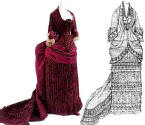Mission name: The ‚Vampire‘ or ‚Worth apprentice‘ gown
(read below for explanation)
Some years ago, when I acquired the ‚Fashion‘ book by the Kyoto costume institute, I was right away captured by one particular gown. It was not exactly my favorite shape – the ‚extreme‘ bustle of the Victorian era; it wasn’t at all my favorite color – a vibrant raspberry red – and being a reception gown with an almost two yards long train, it wasn’t exactly practical, either.
However, the moment I turned the page and saw the picture of this Reception gown by Charles Frederic Worth in the book was the moment when I thought „Damn, I would happily have my hands chopped off afterwards if I could ever lay them on such a fantastic velvet.“ The gown in question – ‚Fashion‘ book owners will probably already know what I am writing about – was this one:
And I vowed that if I would ever find a velvet even just remotely suitable for that gown then I would try to make it.
The years passed, but never ever crossed a matching velvet my path, except once when I saw a cranberry burned out ‚Roses‘ velvet on Ebay, but the amount offered wouldn’t have been enough for the gown.
Then – finally – when I was looking through a curtains store – I found a flock printed organdy with a rather baroque looking pattern in wine / Marlboro red. At first I thought ‚DAMN that’s expensive!‘ – but I found myself in that store afterwards several times, just admiring the bolt of fabric that was lying there.
On the last occasion when visiting that store I found that the bolt was gone, and I thought, damn, yet another opportunity for that fabric is gone.
Lucky me was wrong.
When leaving the shop I passed by the remnants table – and there it was, the tiny bolt that was left of the fabric. 3.7 meters, to be exact, and reduced to half of the original price. I still thought „Hmmm, that might be a little too short for the dress, but still, it might be useful for something.“ So I bought that remnant and carried it home.
I found no rest. Looking through my pattern books, I found a pattern suitable in Janet Arnold’s ‚Patterns of Fashion 2 – 1860-1940‘; the Dinner dress in ivory silk, c. 1882-3 from the London Museum.
The pattern of that dress is much similar to Worth’s above mentioned reception gown, except that the bodice is draped into panniers at the sides, but that was one thing I could easily adjust. See how much likely the shape of both dresses is by looking at a direct side by side comparison:
Side note: I know that my flocked organza is trash compared to the original cut velvet. However, after searching for *any* kind of fabric for this gown for years, I am utterly satisfied with what I have found there. If I should ever find a fabric which would resemble the original cut velvet more and if I can afford it then I would buy it, anyway – to make a second, „ultimate“ version of that gown. And *if* that should ever happen, it will be most helpful if I already had a tested, working pattern and would have practiced making this gown once before 😉
That is why I also call this project the ‚Worth apprentice‘ gown – I’m practicing on something that was created by a master, and for that purpose, flocked organza is sufficient 😉
According to my usual method to enlarge patterns I scanned it and did just that.
Then I photographed the fabric in its width and with one pattern repeat, made a ‚digital fabric‘ from that photographed pattern repeat (meaning – in my case – a 1:10 sized picture of the fabric (15cm wide, 36cm high) and placed the pieces of my enlarged pattern on this ‚digital fabric‘.
I found that if I would make the train in plain fabric and perhaps a border for said train in the flocked velvet, then I would have enough fabric for the gown.
See for yourself:

Pattern pieces (blackened for copyright reasons) placed on the ‚digital piece‘ of 3.7 meters of flock printed velvet (slightly brightened so I could see the pattern better). The white pieces ‚behind‘ the flocked organza are a pattern piece of a different gown that was lying underneath the fabric when I photographed it. The free space at the bottom, between the two (shortened) underskirt panels could become the border for the train.
Note that I have already changed the shape of the bodice, which originally had those panniers, considerably to what I think could be the shape of the Worth bodice – I’ll find out if this is the correct shaping when testing the pattern (with the plain satin which is to become the lining, apron and train for the entire gown).
So I at least knew that I would have enough fabric to make a gown remotely likely to the Worth gown in ‚Fashion‘. I still have to find the perfect satin for lining and decorating the gown, so don’t yet hold your breath about what’s to happen next (though you may, of course, expect that one day I’ll finish this one, which I by now call the ‚Vampire gown‘ because of its blood red coloring).


